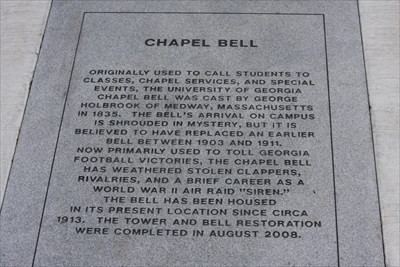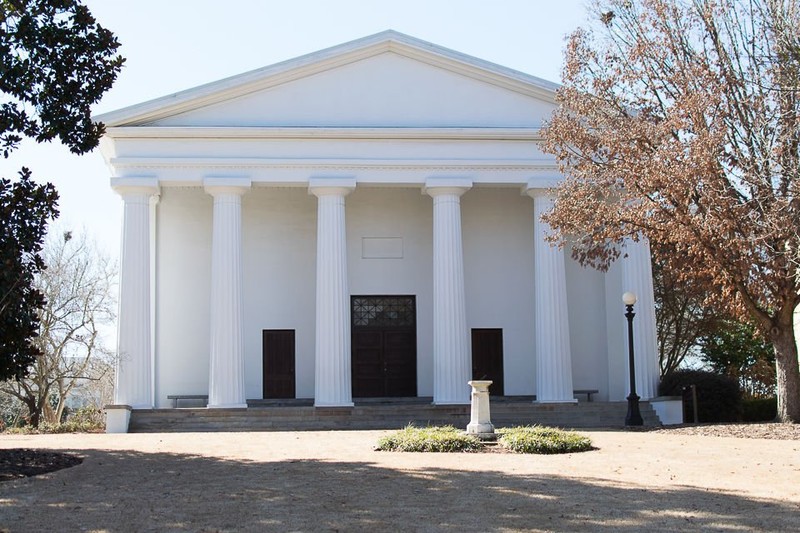University of Georgia Chapel
Introduction
Text-to-speech Audio
Images
The marker in front of the Chapel Bell. http://www.waymarking.com/waymarks/WM8XCC_Chapel_Bell_UGA_Campus_Athens_GA

The University of Georgia Chapel (photo/Samantha Forbes) https://www.redandBlack.com/uganews/photographer-maria-varela-scheduled-to-speak-at-uga-chapel/article_0e0fd456-2b39-11e8-9b0b-438c10a5ac00.html

Backstory and Context
Text-to-speech Audio
In the early days of the university the Chapel was a center of campus activities. A daily mandatory religious service took place there in addition to assemblies and commencements. If you look from the front of the chapel to the quad, you will see a sundial. This sundial marks the site of the famous Toombs Oak. Robert Toombs, a famous senator and Confederate general, was expelled from the university in 1825. As legend has it, he reappeared at commencement and spoke so powerfully under the oak tree that the audience in the chapel left to hear him. While this story is quite romantic, it is not true – but still makes for a great story.
The Chapel became such a landmark of the campus and surrounding community that the city’s boundaries were measured from a midpoint at the base of the chapel steps, and extended in a 360-degree radius several miles away3. During the Civil War, the Chapel served as an army hospital and later as a prison for 431 Northern soldiers taken nearby in 18644. After the war the university was presented with one of the world’s largest framed oil paintings, Interior of St. Peter’s Rome by George Cooke. The painting was presented to the university by Daniel Pratt in 1867.
The famous Chapel Bell was originally located on the chapel roof but in 1913 the tower was found to be rotten and was removed5. The bell was subsequently placed at the top of a wooden tower at the back of the Chapel, where it remains today.
The bell was initially used to call students to chapel as well as to signal class changes, but it had other uses as well. Football was originally played on Herty Field next to the Chapel, and in the 1890s it was the freshmen’s duty to ring the bell after each victory6. During World War II the bell was used for a period as an air raid siren. Now the Chapel Bell is rung in celebration of football wins as well as personal accomplishments such as making an A on a test or graduating. A marker about the bell can be found in front of the bell tower at the back of the Chapel.
1. The University of Georgia, Chapel History & Restoration, (The University of Georgia).
2. Reed, Thomas Walter, History of the University of Georgia, (The University of Georgia, 1949), 128.
3. Ayers, et. al, University of Georgia Physical Master Plan, (The University of Georgia, 1998), 12.
4. Thomas, Frances Taliaferro, Athens, (New Georgia Encyclopedia, 2004).
5. UGA, Chapel History.
6. Marinova, Polina, Lasting Legacies: Chapel Bell Rings of History, (The Red & Black, 2009).
Cite This Entry
Claire Hanna. "University of Georgia Chapel." Clio: Your Guide to History. May 6, 2018. Accessed February 25, 2025. https://theclio.com/entry/59315
Sources
Ayers, Saint, and Gross. University of Georgia Physical Master Plan. University of Georgia. Office of Architects for Facilities Planning. March 11, 1998. Accessed April 23, 2018. https://www.architects.uga.edu/sites/default/files/documents/master-plan-info/sections/i_history_of_the_university_of_georgia.pdf.
The University of Georgia. "Chapel History & Restoration." UGA Tate Student Center. Accessed April 23, 2018. http://tate.uga.edu/weddings/chapel-history.
Marinova, Polina. "LASTING LEGACIES: Chapel Bell Rings of History." The Red & Black, November 2, 2009. Accessed April 23, 2018. • http://tate.uga.edu/weddings/chapel-history.
Reed, Thomas Walter. History of the University of Georgia. Athens, GA: University of Georgia, 1949. Accessed April 23, 2018. • http://dlg.galileo.usg.edu/cgi-bin/ebind2html.pl/reed_c02?seq=92.
Thomas, Frances Taliaferro. "Athens." New Georgia Encyclopedia. Edited by Chris Dobbs. July 27, 2004. Accessed April 23, 2018. • https://www.georgiaencyclopedia.org/articles/counties-cities-neighborhoods/athens.

